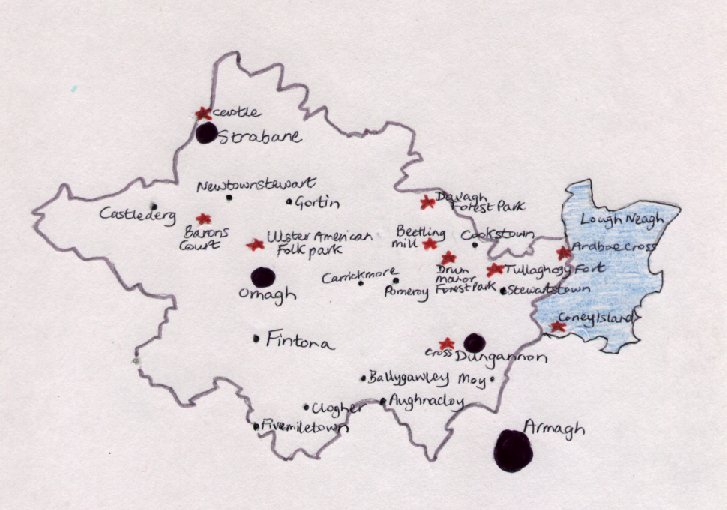|
| Beaghmore Stone Circles
At the foot of the Sperrin Mountains are a huge collection of stone monuments. They date from between 2000 to 1200 BC and there are 7 circles in all, several rows of stones and some other relics that may be collapsed walls or structures. The circles are small, none of the stones used are more than 1.20m (4ft) in height. No one knows what these circles were used for but it is guessed that it had something to do with the movements of the sun and moon. Three of the rows here are arranged to the point where the sun rises on the summer solstice. There are also a dozen round cairns, or burial mounds. Until 1945 this whole site was buried below a layer of peat. Cookstown Cookstown was founded in the 17th century, by Alan Cook, and was a Plantation town. The main road through the town is perfectly straight and runs about 2km (1.25 miles ) long and is 40m (130 ft) wide. There are lots of Neolithic sites in the area, and also early christian ones. The Ardboe Cross This cross was erected in the 10th Century and stands on the site of a 6th century monastery. There are 22 carved panels showing Old Testament and New Testament scenes. Wellbrook Beetling Mill West of Cookstown on the Ballinderry River, this mill is one of the remains of Ulster's old linen business. It was built in 1768, and has been restored by the National Trust. Inside demonstrations show the process of "beetling" which is the hammering of the cloth to give it a sheen., it also shows how loud it could be! Dungannon
Dungannon was once the seat of government of the O'Neill dynasty from
the 14th century. The O'Neill castle was razed during the Plantation.
It became a major linen centre, but now the town is most well known
for Tyrone Crystal. There are tours which show blowing and cutting
glass. Ulster- American Folk Park This is an excellent folk park. there are more than 30 buildings, some copies , some original. There are settler homesteads including the one belonging to John Joseph Hughes, the first Catholic Archbishop of New York. The inside is all furnished in period and its fascinating to see how these people lived. there are also churches, a schoolhouse, compleat with desks and blackboard, a forge and ancient farms. Some house craft displays, all have costumed guides. Perhaps you will see a lady spinning, or baking bread on the open fire. There is also a permanent exhibition called "Emigrants" about those who left Ulster in the 18th and 19th centuries. There is a ship interior which brings home the harsh reality of what life was like on the ships bound for America, and they follow the good and bad fortunes of some of the travellers. The Park is built on ground belonging to Judge Thomas Mellon, founder of the Pittsburgh Banking dynasty.His childhood home has been restored. Ulster History Park At the foot of the Sperrin Mountains the Ulster History Park has full scale models of the types of structures built in Ireland from the times of the earliest settlers. There is a Mesolithic hut, which would have belonged to a hunter/gatherer, dating from 7000 BC, with its roof covered in animal pelts; a megalithic burial mound, or crannog from early christian times; a Norman motte and bailey (a wooden fort on a high mound), and even a 17th century Plantation village. |
